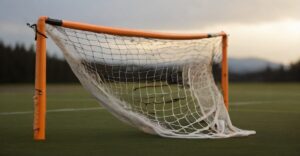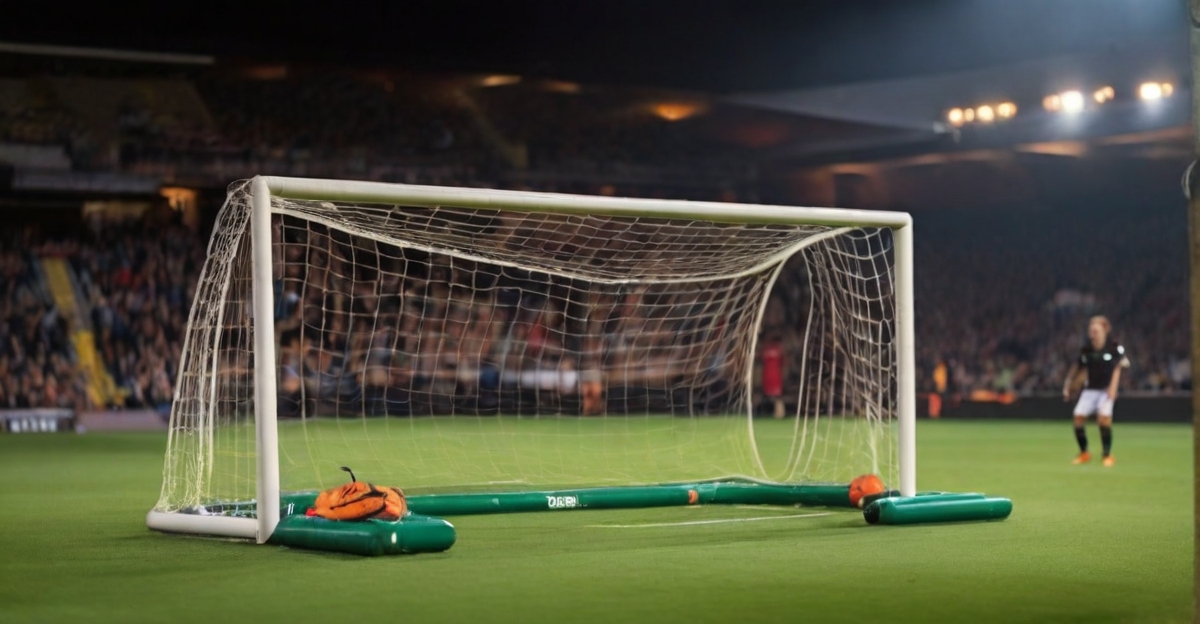Soccer, known as the beautiful game, enthralls millions around the globe. In the heart of this sport lies skill development, a critical aspect for any aspiring or professional player. A soccer bounce back net is an innovative training tool designed to enhance these skills. It’s a simple yet effective device that rebounds the ball back to the player, providing a dynamic way to practice various soccer techniques such as passing, shooting, and controlling the ball.
The significance of these nets in a player’s training regime cannot be overstated. They offer a versatile approach to skill enhancement, enabling players to practice independently or in team settings. Whether in a backyard, a training ground, or a professional facility, these nets serve as a crucial aid in developing and honing soccer skills.
Types of Soccer Bounce Back Nets
In the world of soccer training equipment, bounce back nets come in various forms, each designed to cater to different training needs and environments.
- Stationary Nets: These are fixed in one place and are ideal for consistent rebound angles. They’re perfect for players who want to focus on specific skills like passing accuracy or volleying. Their sturdy construction often makes them a durable choice.
- Adjustable Nets: These nets offer versatility. They can be adjusted for different angles and tensions, providing a range of rebound effects. This feature is particularly beneficial for players looking to practice a variety of shots and passes, as it simulates different playing scenarios.
- Portable Nets: For players and coaches always on the move, portable nets are a blessing. Lightweight and easy to set up, they can be transported to various locations, be it a park, a training field, or a backyard. This type of net is ideal for impromptu training sessions or for teams that do not have a permanent training facility.
Each type of net has its unique advantages, and the choice largely depends on the individual’s training requirements and space availability.
Key Features to Consider
When selecting a soccer bounce back net, it’s important to consider a few key features to ensure you get the most out of your investment.
Size and Dimensions
The size of the net should match the player’s skill level and the type of training they are undertaking. Larger nets provide a bigger target and are thus suitable for beginners, while smaller nets offer a challenge for more advanced players.
Material and Durability
The material of the net and frame determines its durability and suitability for different weather conditions. Look for nets made from high-quality, weather-resistant materials to ensure longevity and consistent performance.
Ease of Assembly
Especially important for portable nets, the ease of assembly can save time and frustration. Nets that come with clear instructions and are easy to set up and dismantle allow more time for training and less time for setup.
Top Brands and Models
Several brands stand out in the market for their quality and reliability. Here’s a look at some of the top brands and their popular models:
NetPlayz
Known for their portable sports nets, NetPlayz offers some of the best options for soccer players. Their nets are lightweight, easy to set up, and highly durable, making them a favorite among coaches and players alike.
SKLZ
A brand synonymous with sports training equipment, SKLZ provides a range of bounce back nets that are both versatile and robust. Their models are often adjustable, catering to a wide range of training needs.
QuickPlay
QuickPlay’s bounce back nets are celebrated for their ease of assembly and portability. Their nets are designed for all age groups and skill levels, offering a good balance between quality and affordability.
PowerNet
PowerNet’s soccer nets are revered for their sturdiness and large size, making them ideal for intensive training sessions. They’re a great choice for players looking to improve their power and accuracy.
Each of these brands offers unique features that cater to different training needs, making it essential to choose a model that aligns with your specific requirements.
Benefits of Using a Bounce Back Net

The utilization of a soccer bounce back net brings a multitude of benefits to a player’s training regimen. Here are some of the key advantages:
- Enhanced Skill Development: Bounce back nets provide a dynamic way to improve fundamental soccer skills such as passing accuracy, ball control, shooting technique, and reaction time. The repetitive nature of the training helps in cementing these skills.
- Versatility in Training: These nets are suitable for a wide range of exercises, accommodating different skill levels and objectives. They can be used for solo practice or in team settings, making them an adaptable tool for various training scenarios.
- Increased Training Frequency: With the convenience of having a personal training tool, players can practice more frequently, leading to quicker skill improvement.
- Safe and Effective: The design of these nets allows for a safe training environment, reducing the risk of ball-related injuries and property damage.
Setting Up Your Bounce Back Net
Setting up your soccer bounce back net correctly is not just a matter of convenience; it’s crucial for safety and the effectiveness of your training sessions. Here are detailed steps and tips to ensure you set up your net properly:
- Choosing the Right Location:
- Space Requirements: Ensure the chosen area is spacious enough for the type of drills you plan to undertake. Consider the net’s dimensions and add extra space for movement and ball trajectory.
- Surface Type: A flat, even surface is ideal. Grass fields, turf, or flat indoor surfaces are suitable. Avoid uneven or rocky terrains that can destabilize the net or cause injuries.
- Safe Surroundings: Check for obstacles like trees, poles, or windows that might interfere with training or get damaged by stray balls.
- Unpacking and Preparation:
- Inventory Check: Open the package and lay out all the parts. Cross-check with the included inventory list to ensure no pieces are missing.
- Read Instructions: Before starting, read through the assembly instructions provided by the manufacturer. This will give you a clear overview of the process and tools needed.
- Assembly Process:
- Frame Construction: Start by assembling the frame. This usually involves connecting tubes or rods, often secured with pins or screws. Make sure each piece is securely connected to avoid collapse during use.
- Attaching the Net: Once the frame is assembled, attach the net. Ensure it’s evenly spread and securely fastened to the frame. Check for any rips or tears that might affect its functionality.
- Adjustments for Tension and Angle: If your net is adjustable, set the desired tension and angle based on your training needs. This might involve tightening straps or adjusting the frame.
- Safety Checks:
- Stability Test: Gently push the net to ensure it’s stable and won’t tip over easily. For nets that require anchoring, make sure they are firmly secured to the ground.
- Regular Inspection: Before each use, inspect the net and frame for any signs of wear or damage. This is crucial for maintaining safety and effectiveness.
- Additional Tips:
- Weather Considerations: If your net is not weatherproof, avoid leaving it outside in harsh weather conditions. This will prolong its lifespan.
- Storage: When not in use, dismantle the net (if portable) and store it in a dry, cool place. This helps prevent damage and keeps it in good condition.
Training Drills and Techniques
To maximize the benefits of a soccer bounce back net, incorporate a variety of drills and techniques into your training sessions:
- Solo Drills: Practice shooting, passing, and controlling the ball using the net. Set specific targets for accuracy and try to hit them consistently.
- Team Exercises: Use the bounce back net for group drills, such as passing sequences or shooting drills. It can be a great tool for developing teamwork and understanding between players.
Maintenance and Care of Your Soccer Bounce Back Net
Proper maintenance and care of your soccer bounce back net are essential to ensure its longevity and performance. Here’s a more detailed guide on how to maintain and care for your training equipment:
- Routine Inspection:
- Frequency: Conduct a thorough inspection of the net and frame at least once a month, or more frequently if used daily.
- What to Look For: Check for any signs of wear, tear, or damage. Pay special attention to the netting, connections, and any moving parts.
- Cleaning the Net and Frame:
- Net Cleaning: Remove debris and dirt from the net using a soft brush or cloth. If the net is detachable, it can be gently washed with mild soap and water. Avoid using harsh chemicals that could degrade the material.
- Frame Cleaning: Wipe down the frame with a damp cloth to remove dust and dirt. Check for rust, especially if the frame is metal. Use a rust remover and repaint the frame if necessary to prevent further corrosion.
- Proper Storage:
- Indoor Storage: If possible, store the net indoors or in a covered area to protect it from weather elements like rain, snow, and extreme sun.
- Disassembly for Storage: For portable nets, disassemble and store in the carrying case if provided. This reduces the risk of losing parts and protects the net from environmental damage.
- Repairing Damage:
- Minor Repairs: Small holes in the net can often be repaired with net repair kits or by hand-sewing. Ensure repairs are secure to prevent further tearing.
- Frame Damage: If the frame is damaged, assess whether it can be safely repaired or if it needs replacement. Always prioritize safety over cost savings.
- Weather Considerations:
- UV Protection: If the net is used in sunny areas, look for nets with UV protection to prevent degradation from sunlight.
- Winter Care: During winter, dismantle and store your net to prevent damage from snow and freezing temperatures.
- General Care Tips:
- Avoid Rough Use: Encourage players to use the net for its intended purpose and avoid climbing on it or using it for rough play.
- Replacement Parts: Keep an eye on wear and tear, and replace parts like nets, connectors, or frame pieces as needed to maintain the net’s functionality and safety.
The Role of Bounce Back Nets in Professional Training
Bounce back nets have become a staple in the training regimens of professional soccer teams, highlighting their importance in developing top-tier talent. Here’s how they are used in professional settings:
- Enhanced Technical Skills: Professional players use these nets to refine their technical skills, including ball control, precision passing, and shooting accuracy.
- Versatility in Training: Coaches incorporate these nets in various training drills, simulating real-game scenarios that help players adapt to different play styles and situations.
- Rehabilitation and Recovery: Injured players often use bounce back nets as part of their rehabilitation process, allowing them to gradually regain their skills and fitness without the need for a training partner.
Safety and Precautions for Using a Soccer Bounce Back Net
Ensuring safety while using a soccer bounce back net is crucial for preventing injuries and accidents. Here’s a detailed guide to help maintain a safe training environment:
- Always assemble the net according to the manufacturer’s guide. Incorrect assembly can lead to instability and potential accidents.
- If the net requires anchoring, make sure it’s firmly secured to the ground to prevent tipping or collapsing during use.
- Ensure there is enough space around the net for safe play. This includes space for the ball to rebound and for players to move freely.
- Set up the net away from windows, roads, and other areas where a stray ball could cause damage or injury.
- Address any issues immediately. Do not use the net until it has been properly fixed.
- Young players should always be supervised by an adult to ensure they’re using the net safely and correctly.
- Avoid using the net in high winds or severe weather, as this can lead to instability and unsafe conditions.
- If playing in sunny conditions, ensure players are protected with sunscreen and hydration.
- When not in use, store the net in a safe, dry place to prevent wear and damage.
- Regularly check the net for any signs of wear and tear. A damaged net can be a safety hazard.
Conclusion
Soccer bounce back nets are invaluable tools for players of all levels. They offer a multitude of benefits, from skill development to versatility in training. By selecting the right type, maintaining it properly, and using it safely, players can significantly improve their soccer abilities. Whether for individual practice, team drills, or professional training, these nets are a smart investment for any serious soccer player or coach.
Frequently Asked Questions
Are football rebounders worth it?
Yes, football rebounders are definitely worth it for players looking to improve their skills. They offer a practical way to practice passing, shooting, and ball control. They are especially valuable for solo training, allowing players to practice without the need for a partner.
How do you use a rebound net in soccer?
To use a rebound net in soccer, position it on a flat surface facing you. Practice different skills like passing, volleying, or shooting by kicking the ball into the net, which then bounces it back. Adjust the angle and tension for varied rebound effects to simulate different game scenarios.
How to make a rebounder for soccer?
To make a DIY rebounder for soccer, you’ll need a sturdy frame (like PVC pipes or wood) and elastic netting. Assemble the frame into a rectangular shape and securely attach the netting, ensuring it’s taut enough to rebound the ball. Remember, DIY rebounders may lack the durability and features of commercial products.
How do I choose a good rebounder?
Choose a good rebounder by considering factors like size, durability, adjustability, and portability. Look for weather-resistant materials if it will be used outdoors. Consider the player’s skill level – larger nets for beginners and smaller, more challenging nets for advanced players.
What is the disadvantage of rebounding?
The main disadvantage of rebounding is the potential for improper use or poor quality equipment leading to injury or ineffective training. It’s important to follow safety guidelines and choose high-quality equipment.
Who should not use a rebounder?
People with existing joint or back problems should be cautious about using rebounders, as the repetitive impact might aggravate these conditions. It’s always recommended to consult with a medical professional if you have health concerns before using rebound training equipment.

